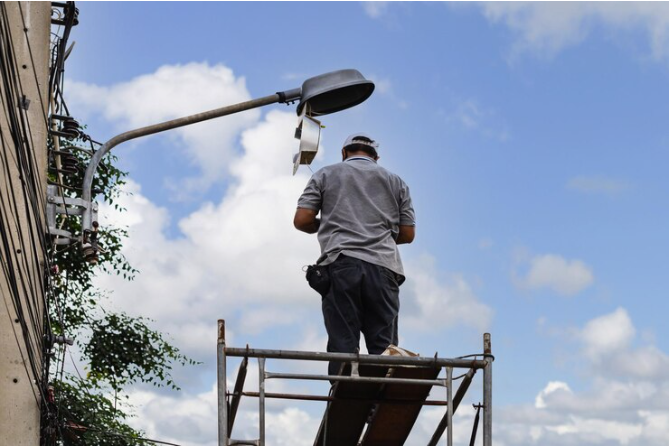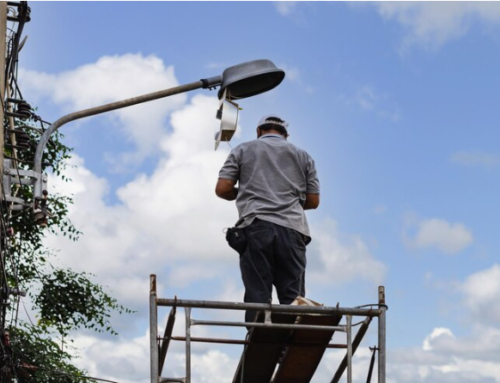As the days get longer and the sun shifts, you may start noticing things about your outdoor lighting that you hadn’t before. The seasonal changes in natural light can reveal design flaws you never realized were there.
From uneven coverage to shadows that aren’t noticeable in the winter, spring’s changing light can highlight areas where your outdoor lighting could use some improvement. It’s the perfect time to assess your setup and make adjustments for better illumination that lasts through the seasons.
How Does Spring Daylight Affect Outdoor Lighting Performance?
The sun doesn’t just show up—it performs a grand, ever-changing dance in the sky, and spring is when it starts shifting into high gear. The angle, intensity, and timing of daylight all start to change in ways that directly affect how your outdoor lighting behaves.
Here’s how spring daylight interferes with your setup:
- Longer Days, Later Starts: Your automatic lighting system may be turning on too early, wasting energy. If your lights are set for 5:30 p.m. activation but it’s still bright outside until 8:00, that’s hours of unnecessary illumination.
- Increased Natural Light Interference: Lights that stood out against a wintery 4:00 p.m. dusk now struggle to compete with lingering twilight.
- Brighter Sky Glow: The softer, more diffused daylight of spring changes how artificial lights appear. Fixtures that seemed cozy and warm in winter can now look washed out or harsh.
- Timer Confusion: Many outdoor lighting systems rely on mechanical or digital timers that aren’t updated for Daylight Saving Time or shifting sunset times. Without reprogramming, they fall out of sync quickly.
The net effect? Lights that once complemented your outdoor space might now feel awkward, unnecessary, or even downright disruptive.
Why Do Some Landscape Lights Look Uneven During Spring Evenings?
One of the more jarring realizations homeowners often have in spring is that their landscape lights suddenly appear uneven. What once was a beautifully balanced arrangement of soft uplights and glowing pathways now looks like someone swapped a spotlight with a flashlight in the middle of the night.
What’s behind this phenomenon?
1. Seasonal Plant Growth
- Plants are waking up—and fast. Shrubs that were dormant in winter may now partially block a light, creating harsh shadows or uneven coverage.
- Newly blooming flower beds may not be adequately illuminated because the lights were installed when nothing was growing there.
2. Changing Surface Textures
- Wet spring soil, moss, or mulched areas can reflect or absorb light differently than dry, snow-covered ground.
- Reflections from puddles or wet pavement can amplify brightness in unexpected ways.
3. Shifting Viewer Perspective
- In warmer months, we use outdoor spaces differently—lounging, dining, or walking pathways more often. This new activity exposes how poorly aimed or unbalanced some fixtures really are.
4. Improper Fixture Placement
- Lights that were installed for aesthetics in the fall or winter may not align well with practical spring use cases, like outdoor dinners or evening gardening.
The result is a patchwork effect—some areas too bright, others too dark—which can ruin the cohesive feel of your landscape design.
What Causes Glare or Dark Spots In Outdoor Lighting During Seasonal Transitions?
Glare and dark spots are like the static of outdoor lighting—they disrupt the experience without necessarily ruining everything. But during seasonal transitions like spring, they tend to become more obvious.
Here’s why:
- Low Sun Angles: In early spring, the sun sets at an angle that may interact directly with your fixtures. This can cause glare where none existed before—especially with poorly shielded or upward-facing lights.
- Unadjusted Beam Angles: If your lighting design was created in winter, the fixture angles may be aligned to highlight dormant features. With new growth and new activity zones, those beams may now be aiming too high, too low, or into someone’s eyes.
- Shifting Shadows: Trees, fences, and architectural features cast longer or shorter shadows depending on the season. Spring evenings create new angles that change how light plays off surfaces.
- Fixture Dirt or Wear: Spring is often the first time in months that you closely examine your fixtures. Dirt, mineral buildup, or cloudy lenses from winter weather reduce light output and create uneven illumination.
- Outdated or Mismatched Bulbs: Using mixed color temperatures or wattages becomes more noticeable as spring clarity increases. Warm-white floodlights next to cool-white path lights? That contrast jumps out as the days grow brighter.
The solution often lies in reassessment—sometimes a simple bulb change or a tilt of the fixture can restore balance. But more often, the answer is a thoughtful redesign based on how you’re using the space now.
How Can Changing Sunlight Angles Highlight Poor Lighting Layout Choices?
Sunlight is nature’s spotlight—and it’s unforgiving. As the spring sun rises higher in the sky and lingers longer into the evening, it begins to illuminate design flaws that were conveniently hidden during the short, dark days of winter.
Poor lighting layout choices that spring tends to expose:
- Over-lit Zones: If you went a little overboard with pathway lights or spotlights, the extended daylight makes them look excessive and out of place. Suddenly, that once-elegant uplight looks like a theatrical production happening in your flowerbed.
- Neglected Corners: Areas that weren’t obvious during winter become usable in spring—but if they weren’t lit properly to begin with, they now feel uninviting or forgotten.
- Underwhelming Focal Points: You may have placed lights to accent a dormant tree or sculpture that now gets overshadowed by spring foliage. What was once a “wow” moment has lost its punch.
- Misplaced Motion Sensors: Warmer weather = more movement outdoors. If your motion-activated lights are angled poorly or too sensitive, they may trip too easily or fail to catch important areas.
Sunlight highlights what’s working and what’s not. And in spring, when more of your yard is in use, any design missteps become obvious.
Spring is a Stress Test for Your Outdoor Lighting
Spring isn’t just a season—it’s a test. As the light changes, the temperature warms, and your outdoor space comes back to life, every part of your landscape lighting design gets evaluated in real time. If your lights don’t adapt, they’ll start to stand out in all the wrong ways.
But here’s the upside: spring is also the perfect time to rethink, readjust, and renew. With better visibility, more time spent outside, and fresh landscaping underway, this season offers the perfect opportunity to realign your lighting system with how you actually use your space.
Let Palmetto Outdoor Lighting Refresh Your Spring Lighting Design
At Starnes Electric LLC, we understand how seasonal changes can dramatically affect the look and function of your landscape lighting. Whether it’s adjusting beam angles, swapping outdated fixtures, or redesigning your entire layout, our expert team can help your outdoor space shine—literally.
Schedule your spring lighting assessment today, and let’s make sure your home’s beauty doesn’t fade when the sun goes down.






